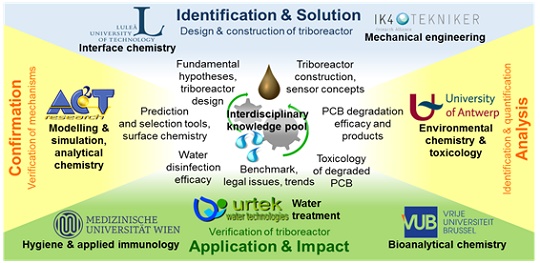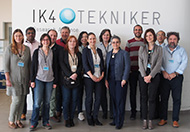triboREMEDY
Breakthrough remediation strategy for safeguarding human and environmental health
triboREMEDY - Breakthrough remediation strategy for safeguarding human and environmental health
Project funded by EUROPEAN COMMISSION, Research Executive Agency
Grant Agreement number: 829047 — triboREMEDY — H2020-FETOPEN-2018-2020/H2020
Principal Investigator
Regina Sommer
Collaborator
Sílvia Cervero-Aragó
Institution
Medical University of Vienna
Status
Ongoing (01.03.2019 – 28.02.2022) 48 months
Partners
Fundación Tekniker “IK4-TEKNIKER” (Coordinator)
20600 Eibar (Gipuzkoa), SPAIN
Francesco Pagano, Elena Fuentes, Raquel Bayon, Wafae Jabri, Amaya Igartua
LULEA TEKNISKA UNIVERSITET
Lulea 971 87, Sweden
Ichiro Minami
UNIVERSITEIT ANTWERPEN
Antwerpen 2000, Belgium
Adrian Covaci, Malarvannan Govindan, Jeong Yunsun
VRIJE UNIVERSITEIT BRUSSEL
Brussel 1050, Belgium
Marc Elsken
MEDIZINISCHE UNIVERSITAET WIEN
Wien 1090, Austria
Regina Sommer, Sílvia Cervero-Arago
AC2T research GmbH
Wiener Neustadt 2700, Austria
Nicole Doerr, Ivana Toth, Lucia Pisarova
URTEK WATER TECHNOLOGIES SL
Lesaca - Navarra 31770, Spain
Iban Isasi

Project summary
triboREMEDY constitutes the foundational step towards the radically new technology of “tribolysis” for safe, controlled, and efficient degradation of hazardous chemicals and inactivation of pathogens using a “triboreactor”, addressing two applications such as degradation of polychlorinated biphenyls (PCBs), and disinfection of drinking water. The long-term vision is to establish tribolysis as indispensable environmental remediation technology realised by modelling and simulation and comprehensive high-end analytical methods – offline and online – as well as high throughput equipment to cope with the extremely ambitious and almost unexplored research subject.
Multi-scale modelling and simulation will be established as tool for prediction of processes and selection of triboreactor configurations and process parameters. Thus, a fundamental understanding of mechanically induced chemical and physical reactions will be generated. Being aware of the topic’s complexity, multidisciplinary sets of analytical methods will be developed to describe degradation mechanisms and the toxicological fingerprint of the degradation products. The triboreactor will be realised as continuous flow high-throughput system. The triboreactor will have a modular character to be suitable for stepwise sequential degradation or as part of more complex structures.
The Triboreactor design, consist of a flow system with well-controllable parameters: contact (velocity, load), reactant (feed rate) and catalyst (tribo-material) with a measurable target of > 90% elimination of hazard chemicals and effective water disinfection at the rate >6 g·h-1 in an easy to scale up flow reactor in continuous operation. Sensors will be used to monitor and control tribolytic process efficacy and fluid quality (measuring active pathogens or PCB evolution). The equipment in the future will be operated in isolated locations or regions with poorly developed infrastructure and stringent (safety) requirements. Both, large stationary plants or mobile devices could be applied for isolated places and domestic frame for defence or civil applications.
The tribolysis can be employed as radically new technology for further applications: preparation of functional surfaces (thin coatings, layered structures, preconditioning, extreme reaction conditions); in-situ reactants (highly active intermediates for chemical synthesis), new catalysts (triboreactor surfaces made of base metals acting as and replacing nobel metals from Pt group), in situ generated nanoparticles defined to provide in a “one-pot” synthesis for optical, sensing, and physiological effects.

